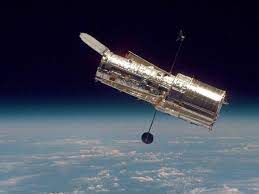Posts Tagged ‘galaxy’
When the Big Picture is Just Too Big
The universe, which is vast, has taken on new dimensions thanks to unwelcomed discoveries from that meddling Hubble Telescope. Just when I was getting comfortable with my place in the 200 billion galaxy cosmos, the Hubble discovers that it’s 10 times larger than originally thought, thereby making me 10 times smaller – thanks a lot Hubble ass-tronomers. Could you make a guy feel any more insignificant?
A galaxy is defined as a localized cluster of stars numbering between a few hundred million (108) stars to one hundred trillion (1014) stars, each orbiting its galaxy’s center. That’s almost as many stars as Adam saw when he first laid eyes on that forbidden fruit known as Eve. Most galaxies are 3,000 to 300,000 LY (light years) in diameter (about the same diameter as Charles Barkley). Galaxies are separated by distances on the order of millions of light years from each other (about the same emotional distance between Atilla the Hun and his estranged son Caitlyn the Hun). And because our immeasurable inky playpen is so crazily proportioned, I began this little essay with the understatement of the epoch: “The universe, which is vast…”
A 60-year-old 3rd Grader Discusses Light

Yes it’s real. Spiral Galaxy not spiraling out of control, but spiraling into control. Such is life.
By definition all discussion about light is illuminating. For example, a light photon is sometimes referred to as a wavicle because it possesses properties of both a wave and an icicle, I mean a particle. It travels at 186,000 miles per second – unless it’s in a construction zone, in which case it slows down to posted speed limits in order to avoid the double penalties. But for the life of me I don’t know why the photon would “play nice” and slow down to avoid a ticket – I mean who’s going to catch it? In theory nothing can travel faster than the speed of light, but I once saw a zebra sprinting at 186,001 miles per second. It’s true. Of course, at the time, the zebra was being chased by a lion doing 186,000 mps. Motivation is where you find it.
But these alphanumeric hieroglyphs I produce with droll ardency cannot touch the absolute enormity of the cosmos. To get some sense of its outlandish proportions one has to approach it with a measure of humor and unorthodox comparisons. For a down to earth, intergalactic comparison (love the mixed metaphor), our Milky Way has a diameter of at least 100,000LY. It is separated from its nearest galactic neighbor, the Andromeda Galaxy, by 2.5 million LY. To put this in perspective, 2.5 million LY is almost as far as PBS’s Rick Steves traveled in 2010. There’s a lot of vacant acreage out there in space just screaming to be developed. Of course no one hears those silent screams because in space there’s only the sound of silence. That might not be totally correct. I think Einstein, Goddard and Elon Musk have all heard the siren call of the eternal cosmic voice – Giuliani, Weinstein and Heinrich Himmler, not so much. Read the rest of this entry »


